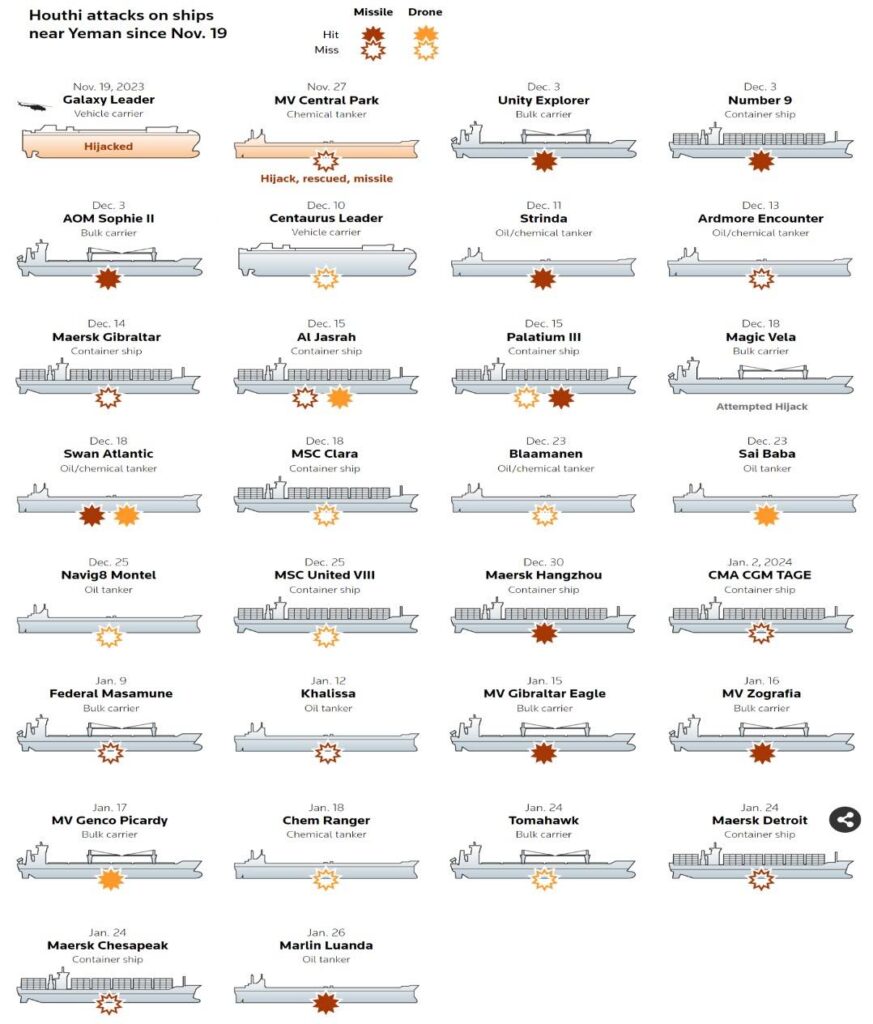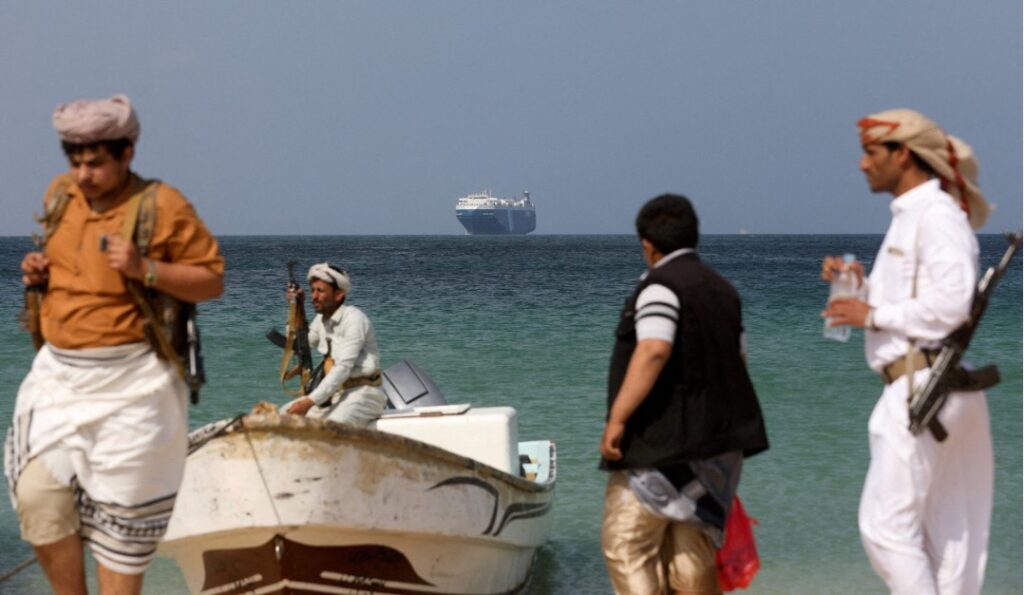The maritime industry has been plunged into turmoil over the past two months, with the Red Sea emerging as a battleground for Houthi rebel groups. Before talking about the overall impact of these attacks on the maritime industry and the global economy, let’s first discuss the Red Sea and the Houthi rebel groups.
The Houthis, also known as Ansar Allah (supporters of God), constitute an armed political and religious group that holds control over majority of Yemen’s north including the strategic Red Sea port city of Hodeidah and capital, Sana’a. Aligned with Iran’s “Axis of Resistance,” an anti-Israel and anti-Western coalition of regional militias backed by the Islamic Republic, the Houthis stand alongside Hamas in Gaza and Hezbollah in Lebanon as one of the three prominent Iran-backed militias.
Over the past two months, the Houthis have disrupted Red Sea maritime trade by targeting ships owned by Israelis or those they suspect are en-route to Israel. The first ship targeted was Galaxy Leader, a British owned and Japanese operated cargo vessel travelling from Turkey to India in the southern Red Sea on November 19, which reportedly was under the ownership of Ray Car Carriers, founded by Abraham “Rami” Ungar, who is known as one of the richest men in Israel. The vessel was seized by the Houthis and has since become a tourist attraction for Yemenis at the port of Al Salif, where it remains anchored while twenty-five crew members remain hostage. Subsequently, the Houthis have extended their attacks to numerous other ships, irrespective of their links to Israel, using cruise missiles, drones, and anti-ship ballistic missiles. As of January 26, a total of twenty-nine ships have been targeted.

The Houthi revolutionists portray their attacks on vessels in the Red Sea as expressions of solidarity with Palestinians. They aim to use the performing dislocations in trade as an influence to prompt Western governments to press Israel into agreeing to a ceasefire in Gaza. contemporaneously, the Houthis exploit the situation to enhance their fashion ability within Yemen. Amid a decade-long conflict, Yemen faces severe profitable and philanthropic heads, with the revolutionists floundering to meet introductory service demands. These maritime attacks deflect attention from original challenges, enabling the Houthis to place themselves as frontline protectors in a broader indigenous conflict between Israel and the United States, all in support of the Palestinian cause.
These attacks took place in the southern Red Sea, the Bab el-Mandeb Strait, the Gulf of Aden and indeed in the Arabian Sea. The Red Sea is a busy shipping lane located south of the Suez Canal, which is a critical raceway connecting the Mediterranean Sea to the Red Sea. At the southern end of the Red Sea is a narrow strait of water – about 20 long hauls wide – between Djibouti and Yemen the Bab el- Mandeb strait, the area that the Houthi revolutionists in Yemen have been targeting. The Gulf of Aden is an extension of the Indian Ocean, put away between the Arabian Peninsula and the African mainland, which connects the Red Sea to the Arabian Sea via the Strait of Bab el Mandeb. About 12 of global trade passes through the Suez Canal each day, counting for 30 of all global vessel business, and over USD 1 trillion worth of goods per annum making it a critically important shipping route.
The attacks on vessels in the Red Sea have added to the dislocations in the maritime assiduity, which was formerly strained by geopolitical pressures in the Black Sea and the impacts of climate change on the Panama Canal. The ongoing conflict in Ukraine has made the Black Sea and Sea of Azov unsafe for maritime transport, with reports of marketable weight vessels falling victim to ocean mines and attacks that have destroyed critical structures and installations. Accordingly, conditioning at Ukrainian Black Sea anchorages like Odesa has come to a halt, dismembering the import of agrarian products through the region. Meanwhile, the Panama Canal, a pivotal route for transnational trade, is facing challenges due to reduced water situations, resulting in a significant drop in total transportation.
In response to these attacks, numerous shipping companies have suspended their passages coursing the Red Sea, concluding rather than diverting to the Cape of Good Hope. Maersk, one of the world’s leading shipping companies, is among the enterprises that have chosen to suspend their Red Sea routes and reroute around the Cape of Good Hope. Other shipping companies taking this measure include MSC, BP, Hapag-Lloyd, CMA CGM, ZIM and Evergreen. Speaking of Evergreen, does that remind you of the commodity? Yes, it’s the boat that blocked the Suez Canal for six days in March 2021.

The Red Sea extremity hasn’t fully stopped trade in the region. Some vessels, especially those carrying less precious weight and are willing to take further pitfalls, still find the trip worthwhile. Current data from Marine Traffic indicates that there are still a fair number of weight vessels and tankers moving through the Bab al-Mandab Strait into the Red Sea and through the Suez Canal, although the figures have dropped compared to ahead.
Anyhow of the route chosen, dispatching companies will face substantial costs. Taking the Suez Canal route has become more precious as weight insurance rates for the Red Sea and Bab al-Mandab passages have spiked due to the heightened threat of attacks. On the other hand, diverting to the Cape of Good Hope increases shipping time by 30 to 50 per cent, leading to advanced energy costs, as a fresh 3,500 navigational long hauls are added to the total distance travelled. also, an increase in shipping time heightens the demand for holders, causing detainments in weight deliveries. According to International Monetary Fund data as of January 22, 2024, the seven-day rolling normal of Bab al-Mandab passages has dropped to 46 per cent compared to the same period last time. Suez Canal passages are at 63 per cent compared to the former time, while Cape of Good Hope passages are over 70 per cent. These trends emphasize the diversion of transnational trade caused by Red Sea attacks, which according to an exploration note from MUFG, are the largest in decades.
The prolonged interruption of the raceway, which connects to the Suez Canal, has disintegrated global force chains. As the extremity has escalated, the ramifications for the global frugality have grown. The electric auto manufacturer Tesla has halted most products at its plant near Berlin for two weeks due to detainments in deliveries of corridor caused by attacks on vessels in the Red Sea. Oil painting prices have also risen, with Brent crude futures adding by $1.12, or 1.4 per cent, settling at$83.55 a barrel, marking their loftiest close since November 30th. Global trade has fallen by 1.3 per cent from November to December, according to Germany’s Kiel Institute for the World Economy.

The swell in shipping costs, measured by Drewry’s World Container Index which tracks the average price of transporting a 40 ft vessel on a weight boat has jumped from 1,521/ 40 ft on December 14, 2023, to 3,777/ 40 ft as of January 18, 2024. This sustained increase in the price situations, nearly three times the position of early December, might boost world affectation by about 0.6 chance points, as Ben May, director of global macroeconomic exploration at the establishment, wrote in a note. still, rates are 45 to 75 below their “epidemic peak” in late 2021.
For India, the Suez Canal route via the Red Sea is vital for trade with Europe, North America, North Africa, and the Middle East. These regions constituted roughly half of India’s exports valued at 18 trillion rupees ($ 217 billion) and roughly 30 per cent of significance totalling 17 trillion rupees ($ 205 billion) in the financial time ending March 2023, as per CRISIL Conditions. The extremity could bring the country further than 30bn in exports for the financial time ending March, hitting 451bn of exports a time ago by about 6.8 per cent, said Sachin Chaturvedi, director-general of the RIS. The pitfalls have pushed Indian exporters to hold back around 25 of the outbound shipments coursing through the Red Sea and roughly 95 per cent of weight vessels from India have been rerouted through the Cape of Good Hope, according to Ajay Sahai, director general of the Federation of Indian Export Associations.
The chaos in the Red Sea is dismembering shipments of colourful goods from India, including tea, spices, grapes, basmati rice, and buffalo meat, leading to losses for exporters. also, the significance of fertilisers, sunflower oil painting, ministry factors, and electronic goods to India are facing detainments, posing the threat of increased costs for consumers. India, the world’s largest rice exporter, annually vessels over4.5 a million tonnes of basmati rice abroad but has seen a drop in demand for basmati rice in the Middle East, the United States, and Europe due to increased costs, while prices drop by roughly 8 per cent in the domestic request. Meanwhile, the force of sunflower oil painting and fertilisers has come tight for India, the world’s biggest importer of vegetable oil painting.
To get through the extremity, the government is trying to resolve the challenge both through political means as well as by icing further credit to exporters. India is engaged in political accommodations with Iran on the attacks on vessels in the Red Sea, while the commerce ministry is working with exporters to iron out their problems. The Indian Navy has also been stationed to ensure the safety of Indian vessels. For now, however, India doesn’t plan to join any transnational nonmilitary coalition, similar to the one led by the US- Operation Substance, to secure weight travelling through the area.
Written by – Anadi Jain
Edited by – Mehansh Barthwal
